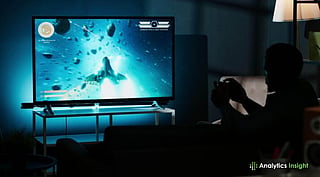
OLED and mini LED TVs dominate gaming in 2025, with Samsung S95F and LG G5 leading in quality, and Hisense and TCL offering strong value.
Gamers should look for 4K 120 to 165Hz refresh rates, VRR support, and four HDMI 2.1 ports to get the best console and PC performance.
Dolby Vision gives Xbox users a visual edge, so LG and Sony models are better for that feature, while Samsung focuses on HDR10 and HDR10 Plus.
The gaming space has evolved immensely, with frequent modifications and new mechanics being introduced to elevate playthroughs and visual appeal. Hardware has advanced along with the environment’s upgrades, providing displays and devices that refine experiences in every category.
Performance-oriented displays have become one of the highest priorities for gamers as they ensure complete visual satisfaction and complement a game’s mechanics well. Let’s take a look at the best gaming TVs that the market has to offer, along with their advanced features, console compatibility, and performance standards.
Samsung S95F QD‑OLED integrates vivid color accuracy, powerful HDR contrast, and a glare‑resistant matte screen for optimal performance. Its four HDMI 2.1 ports enable 4K at 165Hz for PC users, while response times remain nearly instantaneous with negligible input lag. The only missing link is Dolby Vision, relevant mostly to Xbox players using DV‑based content.
Also Read: Upcoming TVs in 2026: What to Expect Next
LG G5 OLED improves upon brightness when compared to its predecessors. The model combines outstanding anti‑reflection performance with exceptional HDR in both movies and games. It also supports a complete gaming suite, including four HDMI 2.1 ports with 4K 120 and VRR.
G5 OLED stands out as one of the most balanced premium TVs, especially if Dolby Vision gaming matters more than the QD‑OLED advantage that other models offer.
This model integrates a bright mini‑LED with 165Hz VRR and FreeSync Premium Pro. U8QG is designed to deliver a great HDR punch and a powerful gaming feature set. It has three HDMI ports total and a unique side USB‑C DisplayPort input that provides 4K165 without HDR.
TCL QM8K combines high brightness, 120–144Hz support on select sizes, and strong performance to provide the perfect gaming experience. Although it provides several premium features, the model still has a few limitations. Users should check the HDMI 2.1 port count if they are connecting multiple consoles and sound systems.
This model is perfect for PS5 features like Auto HDR Tone Mapping, excellent processing, and strong built‑in audio. Bravia 8 II has two HDMI 2.1 ports, ideal if PS5 features matter more than maximum ports or fastest input lag. It is the ideal pick for fast-paced, high-performance gaming.
Also Read: LG Smart TVs on Amazon Sale: Grab Top Discounts Today
Ports & compatibility: If one wants to run both consoles, a gaming rig, and eARC audio, four HDMI 2.1 ports are required. LG and Samsung’s top range models provide this service.
Refresh rate & VRR optimization: 4K at 120Hz is a prerequisite for elite gaming playthroughs. Panels stretching to 144–165Hz elevate PC and performance modes further. FreeSync, G‑Sync, and HDMI‑VRR assist in providing fluid, stutter‑free gameplay.
HDR luminance: Mini‑LED panels are the best-performing displays in sustained brightness tests, while OLED models such as LG G5 and Samsung S95F create new standards while providing peak output with improved reflection control.
HDR format nuances: Dolby Vision matters most for Xbox users, giving LG and Sony models an edge. Samsung continues to favor HDR10/HDR10+, which remains solid for typical content libraries.
For vivid HDR and excellent motion performance, Samsung’s S95F is a strong OLED choice if Dolby Vision isn’t required. Where Dolby Vision gaming and superior brightness take priority, LG’s G5 stands out. In brighter viewing spaces, mini‑LED displays such as Hisense’s U8QG and TCL’s QM lineup balance performance and price well.
Each one of these models supports core gaming factors like 4K 120Hz, VRR, and low input lag, with HDMI 2.1 ports and HDR performance for PS5, Xbox Series X|S, and PC use. Users should consider their desired product’s performance specifications and key features before making a purchase.
What are the best gaming TVs for 2025?
The top gaming TVs for 2025 include Samsung S95F QD-OLED, LG G5 OLED, Hisense U8QG mini-LED, TCL QM series, and Sony Bravia 8/8 II. They offer 4K 120–165Hz, VRR, low input lag, and HDR performance for PS5, Xbox, and PC.
Should I choose OLED or mini-LED for gaming?
OLED TVs like Samsung S95F and LG G5 excel in contrast, color accuracy, and response time, ideal for HDR and fast gaming. Mini-LED TVs like Hisense U8QG and TCL QM series deliver higher brightness, making them better for bright rooms and value-focused setups.
Do I need 8K for gaming in 2025?
8K provides little practical benefit for current consoles or most PCs due to limited content and bandwidth. Prioritizing 4K 120–165Hz, VRR support, low input lag, and strong HDR performance offers better results.
How many HDMI 2.1 ports do I need?
For multiple consoles, a PC, and eARC audio, four HDMI 2.1 ports are ideal. Samsung and LG top-range models provide four ports, while Sony models often offer only two.
Which TV is best for PS5?
Sony Bravia 8/8 II is optimized for PS5 features like Auto HDR Tone Mapping and strong processing. OLED TVs like LG G5 also perform well, but check the HDMI 2.1 port count for multiple devices.
